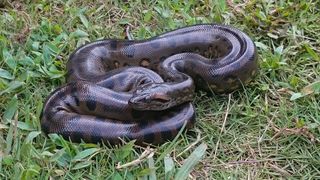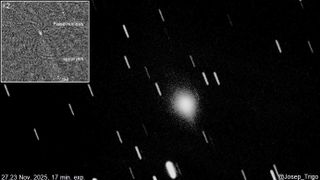Science News: Recent scientific discoveries and expert analysis
Latest news

When an AI algorithm is labeled 'female,' people are more likely to exploit it
By Damien Pine published
People who played the “Prisoner’s Dilemma” were less likely to cooperate when the other player was a male human or AI, and exploited female players.

JWST spots a planet chasing its own atmosphere through space
By Elizabeth Howell published
New James Webb telescope observations of the 'super-puff' planet WASP-107b show that the exoplanet's runaway atmosphere is frantically escaping into space.

Anacondas became massive 12 million years ago — and it worked so well, they haven't changed size since
By Skyler Ware published
The snakes stayed large and thrived even when cooling temperatures and shrinking habitats killed off other giant reptiles millions of years ago.

Law of 'maximal randomness' explains how broken objects shatter in the most annoying way possible
By Skyler Ware published
A new mathematical equation describes the distribution of different fragment sizes when an object breaks. Remarkably, the distribution is the same for everything from bubbles to spaghetti.

Elaborate 2,700-year-old tomb in Greece contains burial of a woman with an upside-down crown
By Kristina Killgrove published
A lavish tomb of a noblewoman discovered in ancient Greece includes a mysterious symbol of lost power.

'We do not know of a similar case': 4,000-year-old burial in little-known African kingdom mystifies archaeologists
By Kristina Killgrove published
Remains of what was likely a funeral feast were discovered in a 4,000-year-old jug in Africa.

Earth had a secret neighbor, and it may explain our moon
By Sharmila Kuthunur published
Earth may have a moon today because a nearby neighbor once crashed into us, a new analysis of Apollo samples and terrestrial rocks reveals.

Interstellar comet 3I/ATLAS is erupting in 'ice volcanoes', new images suggest
By Patrick Pester published
Scientists have observed cryovolcanoes erupting on comet 3I/ATLAS — giving us a new clue about what's inside it.

Russia accidentally destroys its only working launch pad as astronauts lift off to ISS
By Harry Baker published
The recent launch of a Soyuz rocket carrying three astronauts to the International Space Station has caused significant damage to Russia's only launch pad capable of sending humans into space.

Once-in-a-century floods set to become annual events in northeastern US in the next 75 years, study finds
By Brian Owens published
Rising sea levels and storm surges from hurricanes will bring more frequent extreme floods to northeastern U.S. states, including Connecticut, New York and New Jersey.

A 'functional cure' for HIV may be in reach, early trials suggest
By Andrea Teagle, Knowable Magazine published
People infected with HIV must take antiretroviral drugs for life. But promising trials using engineered antibodies suggest that "functional cures" may be in reach.

'Potentially hazardous' asteroid 2024 YR4 was Earth's first real-life planetary defense test
By Andy Tomaswick published
The discovery and swift monitoring of asteroid 2024 YR4 earlier this year represented Earth's first real-life planetary defense test.

Antarctica's Southern Ocean might be gearing up for a thermal 'burp' that could last a century
By Matt Simon, Grist published
When humans manage to cut enough emissions and eventually reduce global temperatures, new research shows the Southern Ocean could kick warming back into gear.

Best beginner cameras for wildlife photography 2025: Nature photography for newbies
By Kimberley Lane published
Start photographing wildlife with ease. The best beginner's wildlife cameras make nature and wildlife photography simple and rewarding.

Are biodegradable plastics really worth the hype?
By Melissa Gaskill published
Plastic pollution is poisoning the planet. Some experts suggest making plastics from more "natural" materials, but research shows those still have risks.

An enigmatic human relative, dark matter discovery and mysterious lights in the sky during nuclear weapons tests
By Ben Turner published
Science news this week Nov. 29, 2025: Our weekly roundup of the latest science in the news, as well as a few fascinating articles to keep you entertained over the weekend.

Scientists are debating a 70-year-old UFO mystery as new images come to light
By Sharmila Kuthunur published
Two new peer-reviewed papers claim thousands of unexplained light flashes in vintage Palomar telescope images show statistical ties to nuclear tests and UFO reports. Not everyone agrees with the paper's conclusion.

That was the week in science: Soyuz launch pad seriously damaged | 'Holy Grail' of shipwrecks | Interstellar object dangers
By Ben Turner, Alexander McNamara, Patrick Pester, Brandon Specktor last updated
Live blog Friday, Nov. 28, 2025: Your daily feed of the biggest discoveries and breakthroughs making headlines.
Get the world’s most fascinating discoveries delivered straight to your inbox.




